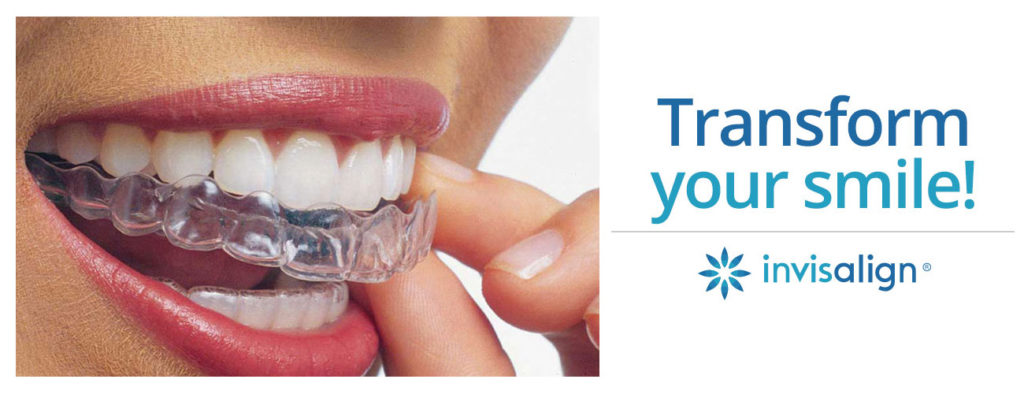
Invisalign has been gaining popularity in recent years as an “invisible,” and thus more aesthetically appealing, alternative to metal braces. Tom Cruise, for one, was famous for using Invisalign. And, for many people, it is a great option.
But, as with anything meant to alter (improve) your smile for life, there are questions that need to be answered – you never want to go into the dentist’s office without the proper knowledge and information. And, while we’re always available to chat and answer your questions live, we thought we’d put together a little primer for you to explain exactly what Invisalign is, how it works, and why it might be a good choice for you.
What is Invisalign?
Invisalign is, to put it simply, a teeth-straightening method. It uses a tray system, called aligners, that operate without the traditional brackets people most associate with braces. The invisible aligners look similar to teeth-whitening trays and are made of a thermoplastic material uniquely developed for the Invisalign treatment plan.
Over the course of the Invisalign treatment, a patient will be supplied with a series of custom-made aligners. When the aligners are placed on the teeth, they cause the teeth to gradually shift from their current position, and each aligner will then make slight adjustments to tooth position. This process is mapped out in advance by your doctor, and the aligners are custom-made specifically for your smile.
After two weeks or so, you will begin using the next set of aligners, which continue the teeth-straightening process so on and so forth.
(Watch the video below for an in-depth look at the process.)
The benefits of Invisalign
Invisalign aligners are virtually invisible – no one will even know that you’re wearing them. No matter what you’re interests, occupation, or how many selfies you’d like to take with full-teeth smiles, Invisalign’s unobtrusive natures makes it a seamless fit with any lifestyle.
Plus, there are no metal brackets or wires that could cause irritation to your mouth, another advantage over traditional braces. Plus, since your office visits during treatment don’t involve metal or wire adjustments, it is like that you’ll spend less time in the doctor’s chair overall.
Invisalign aligners are also removable. Unlike tradition braces, you have the flexibility to remove your aligners to eat and drink what you want during treatment. And you can also remove the aligners to brush and floss as you normally would, for fresh breath and good oral hygiene. For the best results (and a timely outcome), however, aligners should be worn up to 20 – 22 hours per day.
Though they aren’t attached the same way as traditional braces, it is still very unlikely that your aligners would ever fall out, no matter if you’re sleeping, talking, laughing, etc. The aligners are designed to fit firmly on the teeth and are rarely disturbed by any day-to-day activities.
The process also allows you to view your virtual results and treatment plan before you start – this way, you have the opportunity to see how your straightened teeth will look once treatment is complete before you commit.

Procedure
The length of time you spend with Invisalign will depends on the severity of your case: On average, a case takes about 12 months for adults, but the length of time for teenagers is much harder to determine, and only your doctor will be able to give you a timeline.
Your doctor will schedule regular appointments usually about once every six weeks. The goal of these visits is to ensure that your treatment is progressing as planned.
Depending on your specific treatment, some of the movements may require either “attachments” or “ridges” to help the aligner grip the teeth. These bumps, or wells, are where the aligner grips the attachment the doctor places on your teeth. What are these attachments, you ask? The attachments are actually small pieces of enamel-colored composite the doctor affixes to your teeth that are then gripped by bumps on your aligners. Aligners are used to achieve the desired tooth movement.
We won’t lie to you and say that it is a completely painless procedure; some people experience temporary discomfort for a few days at the beginning of each new stage of treatment. This is normal and is typically described as a feeling of pressure. But it’s also a sign that Invisalign is working, as it moves your teeth to their final destination.
Similar to other orthodontic treatments, Invisalign aligners may also temporarily affect the speech of some people, and you may have a slight lisp for a day or two as well. As your tongue gets used to having aligners in your mouth, however, any lisp caused by the aligners should disappear within a few days along with any discomfort.
And there is good news: Thanks to the removable nature of the aligners, you can eat and drink whatever you want while in treatment. In fact, you’re required to remove your aligners to eat and drink. So, unlike when undergoing traditional treatment using wires and brackets, there is no need to restrict your consumption of any of your favorite foods and snacks unless you are instructed otherwise by your doctor. Also, it is important that you brush your teeth after each meal and prior to reinserting your aligners to maintain fresh breath and proper hygiene.
Drinking alcohol (in moderation) won’t interfere with your Invisalign experience, though care should be taken to clean the teeth and the aligners soon after so as not to trap sugar between them. This goes for soda pop or any other sugary beverage you might drink during treatment.
Smoking, however, is something that we don’t recommend while in Invisalign treatment. The braces can become discolored if they come into contact with tobacco smoke and will no longer be as invisible. Gum is also not recommended, as it will stick to the aligners.
Get in contact with Central Dental today to see if Invisalign is something that makes sense for you.
And don’t forget to read our blog on Snoring and Sleep Apnea next.

